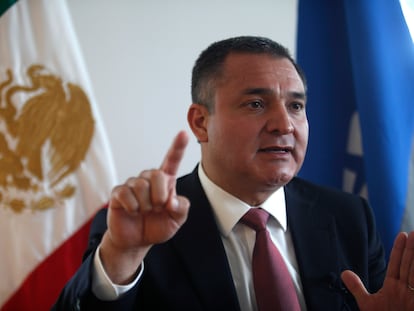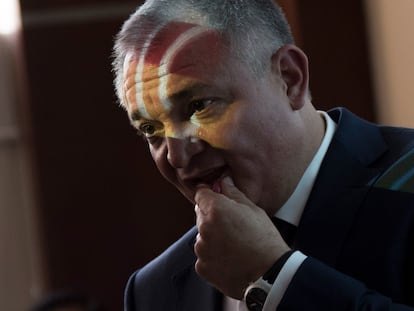García Luna trial reveals how drugs flowed freely through Mexico City’s airport
Prosecutors call a former Mexican cop and a Sinaloa Cartel frontman to testify about how million-dollar bribes greased the wheels of organized crime

Drug traffickers who moved at will through Mexico’s main airports, federal police who helped unload drugs from planes, and coded messages to seal the pact of impunity. Those were some of the main revelations during this week’s hearings in the trial of Genaro García Luna, the Secretary of Public Security in the Felipe Calderón administration (2006-2012). On January 31, the prosecution called Raúl Arellano to testify in a Brooklyn court. Arellano is the first former Mexican police officer to take the stand in the trial. He was followed by Israel Ávila, a frontman for the Sinaloa Cartel, which flooded the country’s airports with cocaine. “I felt exhausted and discouraged, so I decided to retire,” said Arellano, who expressed his disgust with police corruption during the drug war. “The principles I believed in were being completely trampled,” he said. Meanwhile, Ávila is the third person to directly accuse the former official of receiving multimillion-dollar bribes. “The biggest bribe I saw was $5 million,” said Ávila.
79 and 40: the codes for drugs and money
Arellano, a former low-level Federal Police officer, testified first during the hearing. “I would work 25 days in a row and then rest for five days,” he said. In 2006, Arellano was part of the security forces assigned to the country’s most important airport – Mexico City International Airport. His primary responsibility was to guard the terminal against illegal trafficking of “merchandise” – money, weapons and drugs. However, he soon realized that something was off.
Once or twice a week, almost always after an arrival from South America or a departure for Europe or North America, every police officer on duty received the same coded order by radio: “By 45, everyone on 35.” The 45 code meant an order from a superior, and the 35 code indicated “on standby.” In other words, the police were supposed to stand down. “We couldn’t conduct searches, detain anyone – nothing. We just had to stand there,” said Arellano, who appeared in court in a gray, three-piece suit and a lime-green shirt.
While most of the police stood around doing nothing, a “special group” of Federal Police “ignored these orders” and mysteriously disappeared. Later, these officers would return jubilantly to the police cafeteria. “They were happy that ‘the suitcase,’ as they called the illegal cargo, had made it through,” said Arellano. The illegal cargo was money and drugs. “Objection,” barked César de Castro, García Luna’s lead defense attorney. Judge Brian Cogan sustained the objection – the jury would not be allowed to hear that part of the testimony.
Arellano testified that he earned a biweekly salary of 8,000 Mexican pesos (about $400). However, the “special group” officers arrived late, were frequently absent, and showed off luxuries like sports cars and jewelry they couldn’t afford on a policeman’s salary. “They bragged very openly,” said Arellano, who testified about police commanders with gold-plated pistol grips, like Guillermo Báez, a corrupt chief who ended up in prison. Most importantly, the witness connected all the corruption to García Luna, the former head of the Federal Police. “I heard that everyone was happy,” said Arellano, “even the chiefs – Genaro [García Luna], Facundo [Rosas Rosas], Luis Cardenas Palomino – they were all getting a cut.” In other words, the top commanders and the entire chain of command of the Federal Police were on the take. “They talked openly about how well they had done with the ‘suitcase’ full of 79 [drugs] and 40 [money].” De Castro objected again but was overruled this time – the jury would be allowed to hear this testimony.
The real estate agent turned ‘narco’ frontman
In the afternoon, it was Ávila’s turn to testify. A virtual unknown in the narco constellation, Ávila soon made it clear that he had a lot to say. He first told the court how in 2003, he dropped out of college in his fourth semester and began working as a real estate agent. Two years later, some new clients showed up and said they wanted to rent a house in Cuernavaca, the capital of Morelos, south of Mexico City. They said they worked for the Federal Ministerial Police, headed by García Luna during the Vicente Fox administration. They had the unit’s vests, uniforms, credentials, weapons and vehicles, and said they had been assigned to supervise security for the 2005 elections in Morelos.
“I started renting houses for them without really knowing who they were,” said Ávila, who appeared in court wearing a beige prison uniform.
In 2006, Ávila’s clients “killed some people” in one of the rental houses and escaped in a vehicle he had sold them. The police later seized the house. Ávila received a phone call from his clients – they wanted to meet and explain what happened. Ávila agreed to meet in a café, but instead, they took him to a remote area.
“He asked me if I knew whom I was working for.” The man asking the question was Mario Pineda Villa, alias “El MP,” a high-ranking member of the Sinaloa Cartel. Ávila had thought he was just another cop. “Yes,” Ávila replied, “for the police and Genaro García Luna.”
“No, you’re wrong. You and I don’t work for Genaro García Luna – he works for us,” said the narco. Ávila then realized that he had just met his new boss and was working for Joaquin “El Chapo” Guzmán’s criminal organization. He was now officially the Sinaloa Cartel’s landlord.
An Excel worksheet to track bribes
Ávila said he knew everyone: El Chapo; Ismael “El Mayo” Zambada and his brother Jesús “El Rey” Zambada; Arturo Beltrán; Édgar “La Barbie” Valdez Villarreal; and Sergio “El Grande” Villarreal Barragán (the first witness called by the prosecution last week). Ávila provided detailed testimony about how he procured safe houses, warehouses and airplanes for the cartel. He described how he bribed notaries, altered the declared values of luxury properties, and put his name on the deeds of the drug traffickers’ mansions. Ávila became the bookkeeper for MP and his brother, Alberto “El Borrado” Pineda Villa, and used Excel worksheets to manage all the money. “They had millions of dollars in cash,” he said.
Everything was accounted for – drug shipments, property and jewelry purchases, and bribes. Ávila said they bribed public employees at the federal, state and municipal levels “to cover every angle.” The payroll of the Beltrán Leyva Cartel, at the time allied with the Sinaloa Cartel, included Luis Ángel Cabeza de Vaca, the top public security official for the state of Morelos. Cabeza de Vaca, known to drug traffickers as “El Cuernos” or “Vaca,” was charged in Mexico with protecting drug traffickers but was released for lack of evidence in 2016.
The code names for García Luna on the Excel spreadsheets were “El Tartamudo” or “El Metralleta,” mocking allusions to his stutter. Besides the hefty $5 million bribe, Ávila testified that El Rey Zambada paid García Luna many other large bribes: “$3 million, $1 million, $1.8 million... various amounts.” It’s still unclear whether Ávila’s Excel file is part of the prosecution’s evidence that will be presented at trial.
“We went in and got out with their help”
Ávila described how the cartel controlled much of the country in exchange for all the payments. It appointed and fired Federal Police commanders and moved drugs through the country freely with government protection, mainly in Mexico City, Acapulco, Chiapas and Morelos. He testified how in December 2007, the cartel received leaked information that the authorities were tracking one of their planes traveling without a flight plan to an airport in Morelos. The narcos moved quickly to avoid interception of the aircraft carrying 2,650 pounds (1,200 kilos) of cocaine. It was the federal police who had alerted the cartel. “I went with some of the cartel and federal police officers to the airport, where other federal police were waiting for us,” said Ávila. The officers escorted the narcos to the tarmac and helped them unload the plane. They were then allowed to escape and hide in a safe house while things settled down. “They were supposedly looking for us,” recalled Ávila. “What do you mean ‘supposedly?’” asked Assistant US Attorney Erin Reid. “We went in and got out with their help,” replied the witness. The narcos could listen to the entire search operation on the police radio frequency – it was all a sham.
Ávila confirmed several aspects of Villarreal Barragán’s testimony, such as when García Luna was allegedly kidnapped for a few hours by the Beltrán Leyva group. Ávila testified how he was tortured by the cartel when they thought he had betrayed them. They beat, cut and burned him – Ávila still bears the marks on his body. MP, his first direct boss, led the cartel’s brutal test of loyalty.
Ávila admits to participating in the torture and murder of the Pineda Villa brothers when the Beltrán Leyva organization was fighting an all-out cartel war. “I was there when Mario [Pineda Villa] died,” he said. The Pineda Villa brothers had also been accused of betrayal, but unlike Ávila, El MP and El Borrado dumped their bodies on a highway between Cuernavaca and Mexico City.
After a fierce battle with the prosecution earlier in the week, García Luna’s lawyers stumbled. During his cross-examination of Arellano, De Castro could not get the witness to waver or contradict himself. The defense lawyer seemed unnerved by the way Arellano paused to think carefully before every reply and never budged.
DEA agent tells court García Luna was on the radar a decade ago
The US Drug Enforcement Agency (DEA) began following Genaro García Luna over a decade ago according to Miguel Madrigal, an anti-narcotics agent who was called to testify on Thursday in the ongoing trial of Mexico’s former chief of public security. Following the arrest of Sergio “El Grande” Villarreal Barragán in September 2010, Madrigal interviewed the cartel capo and gleaned information about bribes García Luna allegedly received from the Beltrán Leyva criminal organization. Madrigal, who served in the agency’s Mexico office between 2008 and 2015, did not specify the date of the meeting but told the court that the capo gave “detailed information about those deals.” The witness also spoke about Champs Elysées, a luxurious restaurant in the capital across the street from the US Embassy, where the money drops took place, according to intelligence sources. “We had information that high-ranking officials received bribes from the cartels there,” he said.
Madrigal pointed out in several images where the restaurant was located on the map and said US agents went there to see if they could find information that would help them learn more about the money deliveries. “We were looking for cameras,” he said, but there weren’t any. The DEA was particularly concerned about the information it had received because it was constantly exchanging sensitive data on criminal groups with the Federal Police, at the time under President Felipe Calderón's command. They shared intelligence, phone tracking, the locations of suspicious addresses and the tracking of drug traffickers’ vehicles.
Madrigal singled out Édgar Bayardo, a former Federal Police commander. After the 2008 cartel war between Joaquin “El Chapo” Guzman’s Sinaloa Cartel and the Beltrán Leyva brothers’ faction, the DEA began to realize that Bayardo was only sharing information with them about high-ranking members of the latter, such as Édgar “La Barbie” Valdez Villarreal and Harold “El Conejo” Poveda. Nothing was forthcoming on Sinaloa Cartel allies such as the Zambada brothers, raising the suspicions of the DEA.
Shortly thereafter, a DEA source handed Madrigal a video showing Bayardo’s car parked outside one of the homes of Jesús “El Rey” Zambada, who was the Sinaloa Cartel’s handler and in charge of delivering bribes to Garcia Luna, according to testimony from other witnesses in the trial. “We informed our bosses that Bayardo was receiving bribes from El Rey,” Madrigal told the court. His superior passed a report to Bayardo’s supervisor, Federal Police Commissioner Victor Garay. After they had located El Rey, the two forces coordinated an effort to capture him, but the cartel kingpin had already fled. Suspicions of leaks and betrayals grew.
Jesús Zambada was eventually arrested in October 2008, in an operation mounted without the Federal Police. When Madrigal told Bayardo about the capo’s detention, the conversation was short. “He looked worried,” the agent, who is currently stationed in Texas, recalled. “I thought it was strange.” From that point, the witness stated, he limited the amount of information he shared with his Mexican counterparts and that they in turn started to act “with caution.”
Bayardo became a protected witness in December 2008 in a case involving the collusion of government officials with cartel members, particularly the Sinaloa Cartel. He was assassinated in December 2009 in a Starbucks in Benito Juárez, south of Mexico City. According to reports on the murder, Bayardo had been acting as an informant for the DEA, the Federal Police and the Sinaloa Cartel. He was gunned down by two hitmen, who also seriously wounded his bodyguard and a female customer.
Sign up for our weekly newsletter to get more English-language news coverage from EL PAÍS USA Edition
Tu suscripción se está usando en otro dispositivo
¿Quieres añadir otro usuario a tu suscripción?
Si continúas leyendo en este dispositivo, no se podrá leer en el otro.
FlechaTu suscripción se está usando en otro dispositivo y solo puedes acceder a EL PAÍS desde un dispositivo a la vez.
Si quieres compartir tu cuenta, cambia tu suscripción a la modalidad Premium, así podrás añadir otro usuario. Cada uno accederá con su propia cuenta de email, lo que os permitirá personalizar vuestra experiencia en EL PAÍS.
¿Tienes una suscripción de empresa? Accede aquí para contratar más cuentas.
En el caso de no saber quién está usando tu cuenta, te recomendamos cambiar tu contraseña aquí.
Si decides continuar compartiendo tu cuenta, este mensaje se mostrará en tu dispositivo y en el de la otra persona que está usando tu cuenta de forma indefinida, afectando a tu experiencia de lectura. Puedes consultar aquí los términos y condiciones de la suscripción digital.
More information
Archived In
Últimas noticias
Aquilino Gonell, former Capitol sergeant: ‘If it hadn’t been for the police, the US would be a dictatorship’
A hybrid building: Soccer pitch, housing, and a shopping mall
Europe urges Trump to respect Greenland following annexation threats
Science seeks keys to human longevity in the genetic mixing of Brazilian supercentenarians
Most viewed
- Alain Aspect, Nobel laureate in physics: ‘Einstein was so smart that he would have had to recognize quantum entanglement’
- Mexico’s missing people crisis casts a shadow over World Cup venue
- Why oil has been at the center of Venezuela-US conflicts for decades
- Trump clarifies who is ultimately in charge in Venezuela: ‘Me’
- Mexico seeks to shore up its defenses following US incursion in Venezuela











































